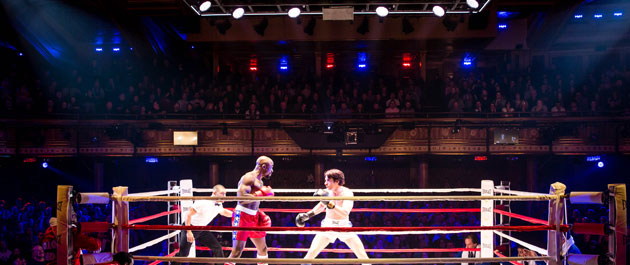ETC systems take over Broadway
Date Posted: 5/29/2014

The summer Broadway season is heating up and the Tony® Awards are just around the corner. Both long-running shows and new productions are getting accolades for their incredibly ambitious and striking lighting designs that are created with the latest technology. In every show on Broadway, ETC equipment plays a big part in accomplishing the awe-inspiring lighting creations, especially ETC's trusted lighting control systems, which can be found in nearly every Broadway house.
ETC's Eos® control family - made up of Eos Titanium (Ti™), Gio®, Ion® and Element™ desks - is the most prevalent on Broadway. The family was developed to be both designer- and programmer-friendly with its powerful software and direct programming syntax. "Most desks are designed solely for the programmer," explains ETC Eos Product Manager Anne Valentino. "We paid attention to what the lighting designer and assistant lighting designer needed, and determined how the show data can be best represented."
One major reason why professionals love Eos-family consoles is their ease of use in deepening levels of technical complexity. "You don't need to know everything in order to use an Eos-family console," says Valentino. "The user interface allows individuals to get important information quickly and lets users work from either an abstract visualizer or in a straightforward command sequence."
Even on massive, technically elaborate shows - such as Tony Award-nominated productions Rocky and Act One - the power of Eos-family consoles is overwhelmingly evident.
Hailed as a "technical knockout," Rocky uses a Ti to control its massive lighting rig, which doubled in size after its original run in Hamburg, Germany, and includes dozens of automated fixtures, 12 Selador® Classic™Vivid-R™ LED luminaires, 59 Source Four® fixtures and 1,287 Source Four PAR™ units. The show's Ti is also used to trigger several powerful d3 4U media servers that control the many video screens and projectors that appear throughout the show, including a 12x10' flying video wall, a real-life Jumbotron and a 24-monitor fish tank wall. Lighting designer Chris Akerlind says that "knowing how to navigate Eos via a trusted programmer made the proliferation of all this equipment much easier."
Illuminating the set of Rocky was no small undertaking. Akerlind describes it as a "3D chess-like set - a physical space that is never aligned the same way twice," which is why precision and complete transparency in controlling each fixture was essential. He especially appreciated the intelligent way that Ti tracks each fixture and moving light, thanks to the live feedback provided by the console's RDM connections. "It's very designer-friendly," he says.
Act One at the Lincoln Center also uses a Ti to manage its sizable lighting rig for the show's giant, 65-foot, three-story 'turntable' rotating set. "I did not know where the turntable would stop exactly and if it would always go to the same position each time we went back to a particular set," explains lighting designer Ken Billington. For that reason, the show's lighting rig uses 40 moving heads and two followspots, in addition to 21 ETC Source Four Revolution® automated fixtures. "It is a complicated light plot, but it worked out well," comments Billington.
When it came to selecting a console, "using an Eos Ti just made the most sense," explains Billington. Instead of multiple consoles segmenting control of the show's many technical elements, Ti is more than sufficient to handle anything Billington's crew could throw at it. "Why rent two different consoles to do the job of just one?" he notes.
Billington, who is fast approaching his 100th Broadway production, has been an ETC lighting console user since he began working on the very first Obsession console in 1992. Also a Broadway veteran and longtime ETC console user, Akerlind says: "I hardly ever use anything other than Eos." Part of the reason that designers and programmers continue to use ETC consoles is that the language and data structure has carried over from legacy desks into the Eos products of today, so users already have the knowledge necessary to talk to the consoles. "Eos was definitely built from the ground up with modern rig-control tools at its forefront, while still being approachable to legacy users," explains ETC field project coordinator Nick Gonsman.
In addition to creating the tools that Broadway lighting professionals have relied on for years, ETC also provides unmatched support. ETC's East Coast office - located in the heart of the theater district - has a programming lab open to the community that includes a full suite of Eos-family control products, visualization options and the ability to connect devices to a system that replicates a typical show environment. The lab is used by industry professionals to prep show design, review design files and test lighting rigs. "Whether it is through our consoles, lighting fixtures or our programming lab," says Valentino, "ETC is thoroughly committed to providing our users with the best support and user experience possible."
Photo © Matthew Murphy